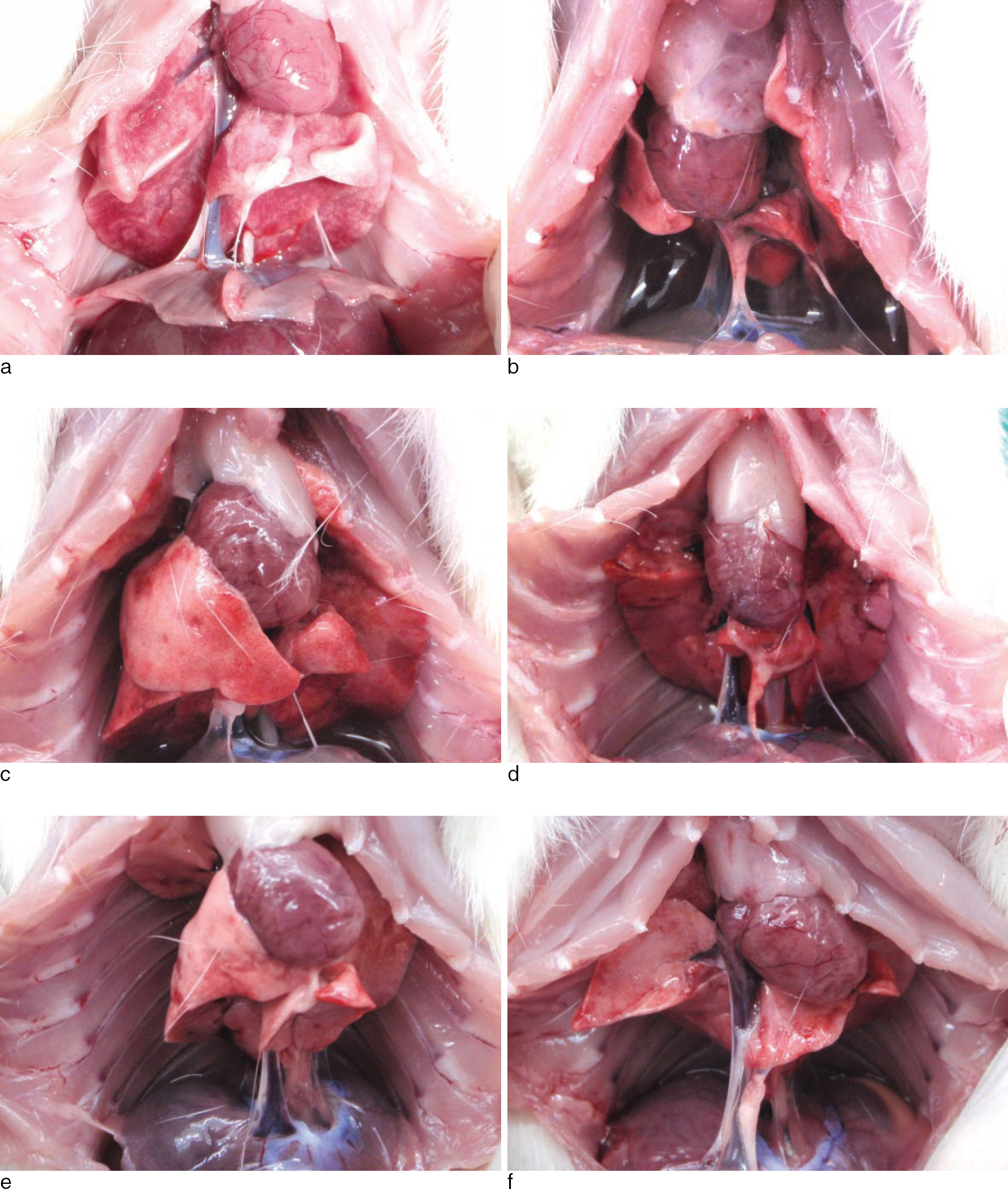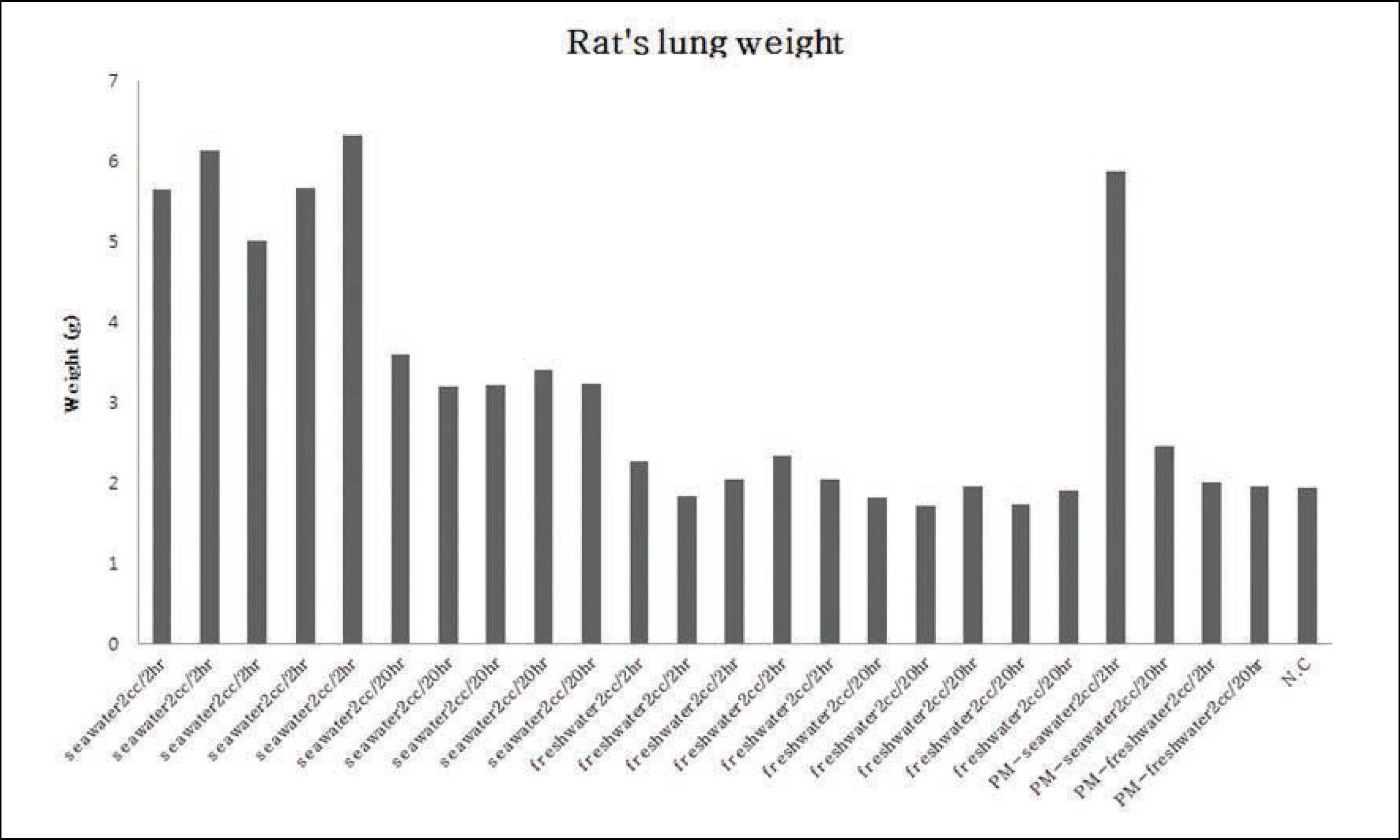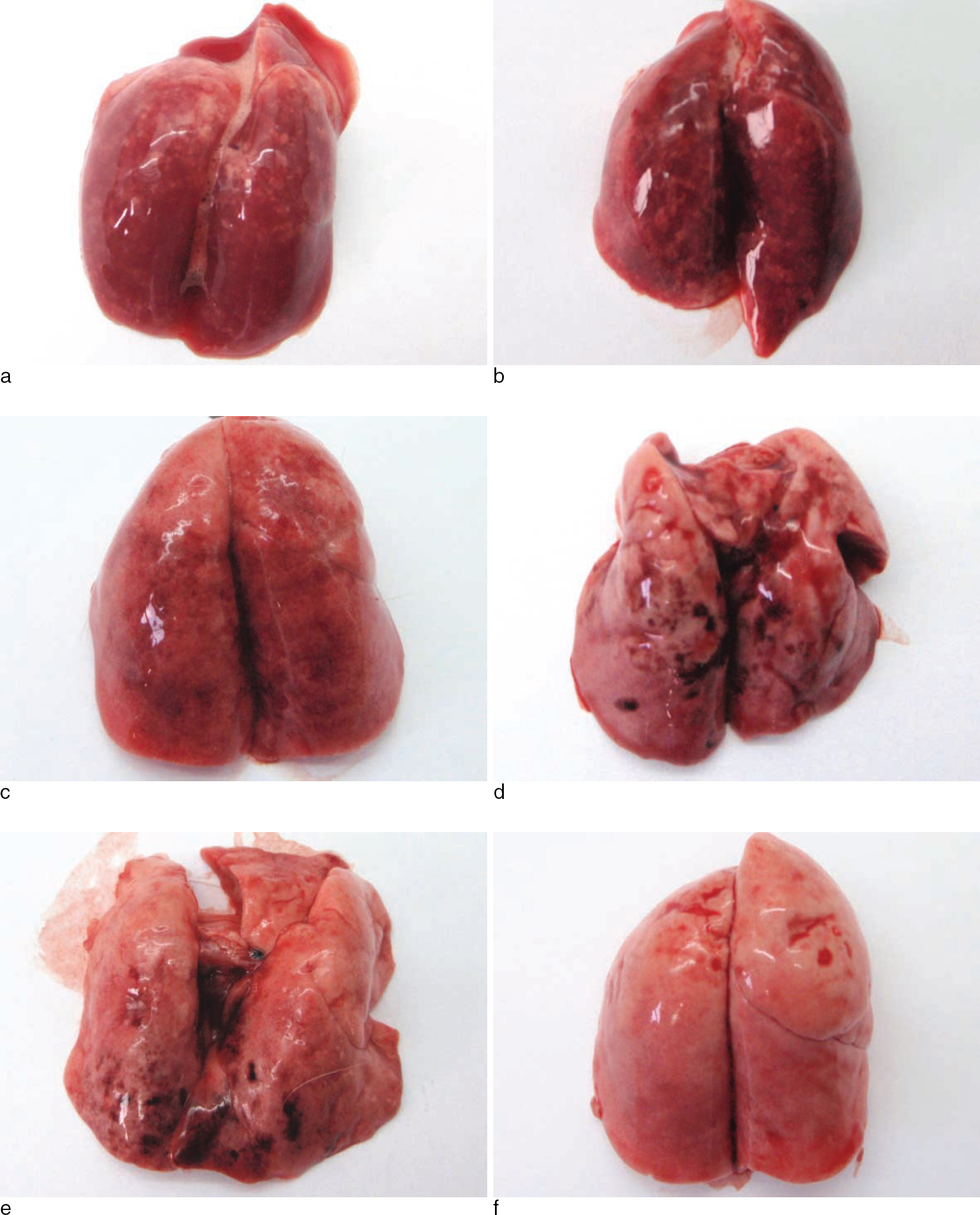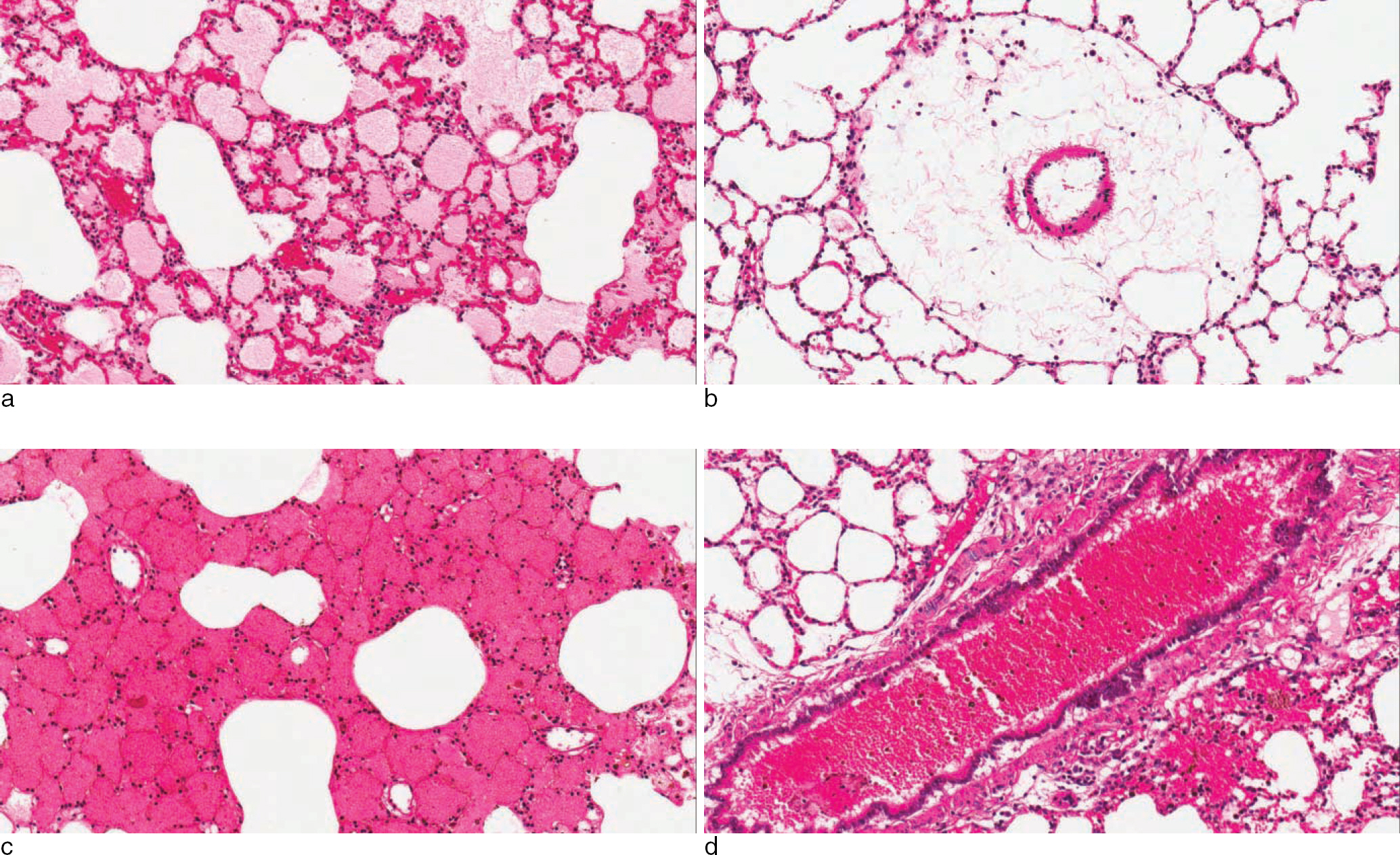Korean J Leg Med.
2013 Aug;37(3):119-128. 10.7580/kjlm.2013.37.3.119.
Comparison of Pathologic Findings by Seawater or Fresh Water Drowning on the Experimental Animals
- Affiliations
-
- 1Department of Forensic Medicine, Chosun University School of Medicine, Gwang-ju, Korea. ysk007@hotmail.com
- 2Department of Pathology, Chosun University School of Medicine, Gwang-ju, Korea.
- KMID: 2305463
- DOI: http://doi.org/10.7580/kjlm.2013.37.3.119
Abstract
- Death by drowning is a major cause of unnatural death worldwide. It is therefore important to conduct forensic examination of immersed bodies following drowning, in order to determine the diagnosis of drowning, because no specific methods have been established thus far. Therefore, we performed a series of rat experiments to compare autopsy findings between seawater and fresh water drowning cases, which included the presence of pleural effusion and histologic findings of the lung. The results showed that the volume of pleural effusion increased in the seawater drowning group compared to the fresh water drowning group, and the total weight of lung was affected by the type of drowning medium and postmortem interval. However, histologic findings of the lung showed no significant difference between the 2 types of drowning mediums.
Keyword
Figure
Reference
-
1. Krug EG, Sharma GK, Lozano R. The global burden of injuries. Am J Public Health. 2000; 90:523–6.
Article2. van Beeck EF, Branche CM, Szpilman D, et al. A new definition of drowning: towards documentation and prevention of a global public health problem. Bull World Health Organ. 2005; 83:853–6.3. Davis JH. Autopsy findings in victims of drowning. Modell JH, editor. The Pathology and Treatment of Drownings and Near-Drowning. Illinois: Charles C Thomas Publisher;1971. p.p. 74–82.4. Morild I. Pleural effusion in Drowning. Am J Forensic Med Pathol. 1995; 16:253–6.
Article5. Idris AH, Berg RA, Bierens J, et al. Recommended guidelines for uniform reporting data from drowning: the “Utstein style”. Resusciatation. 2003; 59:45–57.6. Kringsholm B, Filskov A, Kock K. Autopsied cases of drowning in Denmark 1987-1989. Forensic Sci Int. 1991; 52:85–92.
Article7. Halmagyi DF. Lung changes and incidence of respiratory arrest in rats after aspiration of sea and fresh water. J Appl Physiol. 1961; 16:41–4.
Article8. Reidbord HE, Spitz WU. Ultrastructural alterations in rat lungs. Changes after intratracheal perfusion with fresh water and seawater. Arch Pathol. 1966; 81:103–11.9. Fuller RH. The 1962 Wellcome prize essay. Drowning and the postimmersion syndrome. A clinicopathologic study. Mil Med. 1963; 128:22–36.10. Miloslavich EI. Pathological anatomy of death by drowning. Am J Clin Pathol. 1934; 4:42–9.
Article11. Toklu AS, Alkan N, Gurel A, et al. Comparison of pulmonary autopsy findings of the rats drowned at surface and 50 ft depth. Forensic Sci Int. 2006; 164:122–5.12. Nishitani Y, Fujii K, Okazaki S, et al. Weight ratio of the lungs and pleural effusion to the spleen in the diagnosis of drowning. Leg Med. 2006; 8:22–7.
Article13. Sugimura T, Kashiwagi M, Matsusue A, et al. Application of the drowning index to actual drowning cases. Legal Med. 2010; 12:68–72.
Article14. Yarulmaz C, Arican N, Afacan I, et al. Pleural effusion in bodies recovered from water. Forensic Sci Int. 2003; 136:16–21.15. Terazawa K, Haga K. The role of pleural effusion in drowning. Am J Forensic Med Pathol. 1996; 17:173–4.
Article16. Modell JH, Bellefleur M, Davis JH. Drowning without aspiration: is this an appropriate diagnosis? J Forensic Sci. 1999; 44:1119–23.
Article17. Modell JH, Moya F. Effects of volume of aspirated fluid during chlorinated fresh water drowning. Anesthesiology. 1966; 27:662–72.
Article18. Modell JH, Moya F, Newby EJ, et al. The effects of fluid volume in sea water drowning. Ann Intern Med. 1967; 67:66–80.19. Lunetta P, Modell JH, Sajantila A. What is the Incidence and Significance of “dry-lungs” in Bodies Found in Water? Am J Forensic Med Pathol. 2004; 25:291–301.
Article20. Orlowski JP, Szpilman D. Drowning. Rescue, resuscitation and reanimation. Pediatr Clin North Am. 2001; 48:627–46.
- Full Text Links
- Actions
-
Cited
- CITED
-
- Close
- Share
- Similar articles
-
- Evaluation of Sodium and Chloride Biochemical Tests in Drowning Autopsy Cases
- A Study of Weight Ratio of Lung to the Spleen for the Diagnostic Index of Drowning
- Application of Green Algae Habitating along the Streams in Chungju Province onto the Diagnosis of Drowning
- Analysis of Diatom Detection Result for Immersed Bodies in Honam Area in 2008
- Analysis of the Clinical Features and Prognostic Factors in Sea Water Drowning Patients





